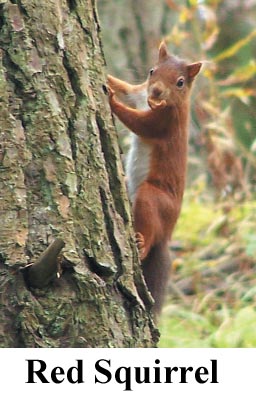| Dalkey Tidy Towns |
  |
| Dalkey Tidy Towns |
  |
Wildlife
Newsletter for the Township of Dalkey February 2010 - Michael Ryan |
| MAGIC
FOREST |
|
|
Red
Squirrel feeding inside the specially designed feeder cage at Tollymore
Forest Park. Note the entrance hole, small enough to stop adult
Greys getting in, with the metal plate around it to stop the greys
widening it by biting through it. Photograph by Janette Adams |
| We
returned to the river walk then saw The Hermitage. This is a folly type
cluster of steps leading down to little stone chambers perched on the edge
of the gorge constructed out of the local rock and blending in beautifully
and very naturally. Further down we saw one red squirrel on a large oak tree
perched on the ravine edge. We returned to the forest a few days afterwards
on a lovely autumnal morning and set off on a different route. We’d
walked a few miles and realized the track we were on seemed to be going out
of the forest so turned around and crossed the river. A very cheerful lady
who we’d met earlier, greeted us again as she passed us with her dog.
We reckoned she knew where she was going so followed her up a rising path
into the woods, past a house and garden surrounded by trees but then she stopped
and came back down the path. We asked her for directions and she told us this
track led out to a road. She was advising us which path was most scenic to
walk along when, perhaps noticing our binoculars, she commented there were
red squirrels in the forest. We told her that was one reason we were there
and she then told us she was involved in the Squirrel Action Group. The house
we’d just passed was in fact hers and she asked us did we want to come
in to her garden where we might see some red squirrels feeding. I couldn’t
believe our luck but kept in mind that this was real life, not TV, and there
was no guarantee we’d actually see any squirrels. I needn’t have
worried. My companion almost instantly saw a red which disappeared on our approach but then more red squirrels started appearing, making their way down through the trees and hopping from fence post to fence post towards the food, a mixture of maize, hazel nuts and peanuts. The squirrel group had developed a wire cage which had an entry hole wide enough that reds could get through but the bigger adult greys couldn’t. The greys had been eating through the metal plate surrounding the hole to widen it on earlier models of the cages so the group had developed a galvanised plate for the cage which had proven resilient to the greys efforts. Janette, the house owner, told us that sometimes when she’s refilling the feeders (always wearing surgical gloves to prevent infection) she would turn around to find a young red squirrel sitting on the ground behind her waiting trustingly for its food. While we were there five individual red squirrels came in to the garden although apparently this was quite a low number since there was still lots of natural food around and in the past she’d had up to 18 red squirrels at one time. She also leaves out cuttlefish bones, like you’d see in bird cages which are to provide calcium for the squirrels’ diet. We couldn’t have wished for a more fortuitous meeting and when we left to wander back through the trees, spectacular in their autumn colours the forest seemed to have become even more magical. I’d forgotten my camera which is probably as well since I’d have spent hours trying, and probably failing, to capture the natural beauty of the place but there’s a website http://www.niphotos.com/tollymoreforest/h399f1182 / slideshow that has some wonderful photos of the forest. |
 |